Doctrine of Precedent: Impact on Australian Legal Framework
VerifiedAdded on 2023/06/10
|9
|2637
|493
Report
AI Summary
This report provides a comprehensive analysis of the Doctrine of Precedent within the Australian legal framework. It begins by examining the case of Kakavas V Crown Melbourne Limited, highlighting the absence of a general duty for casinos to protect gamblers and the significance of High Court decisions for lower courts. The report delves into the concept of duty of care in gambling cases and the reluctance of courts to impose liability, particularly concerning economic losses. It explores the doctrine of precedent, emphasizing its role in judicial decision-making and the hierarchy of Australian courts, including the implications of the Farah Constructions Pty Ltd v Say-Dee Pty Ltd case on state and territory courts. The report further discusses the High Court's power to overrule previous decisions, especially in constitutional cases, and the obligations of judges to adhere to legal precedents. It concludes by summarizing the interconnectedness of precedent and hierarchy, highlighting the application of ratio decidendi and obiter dicta within the Australian court structure. The report references key cases such as Imbree v McNeilly, Cook v Cook, and Attorney-General for NSW v Perpetual Trustee Co (Ltd) to support its analysis, providing a detailed overview of the doctrine's impact on the legal system.
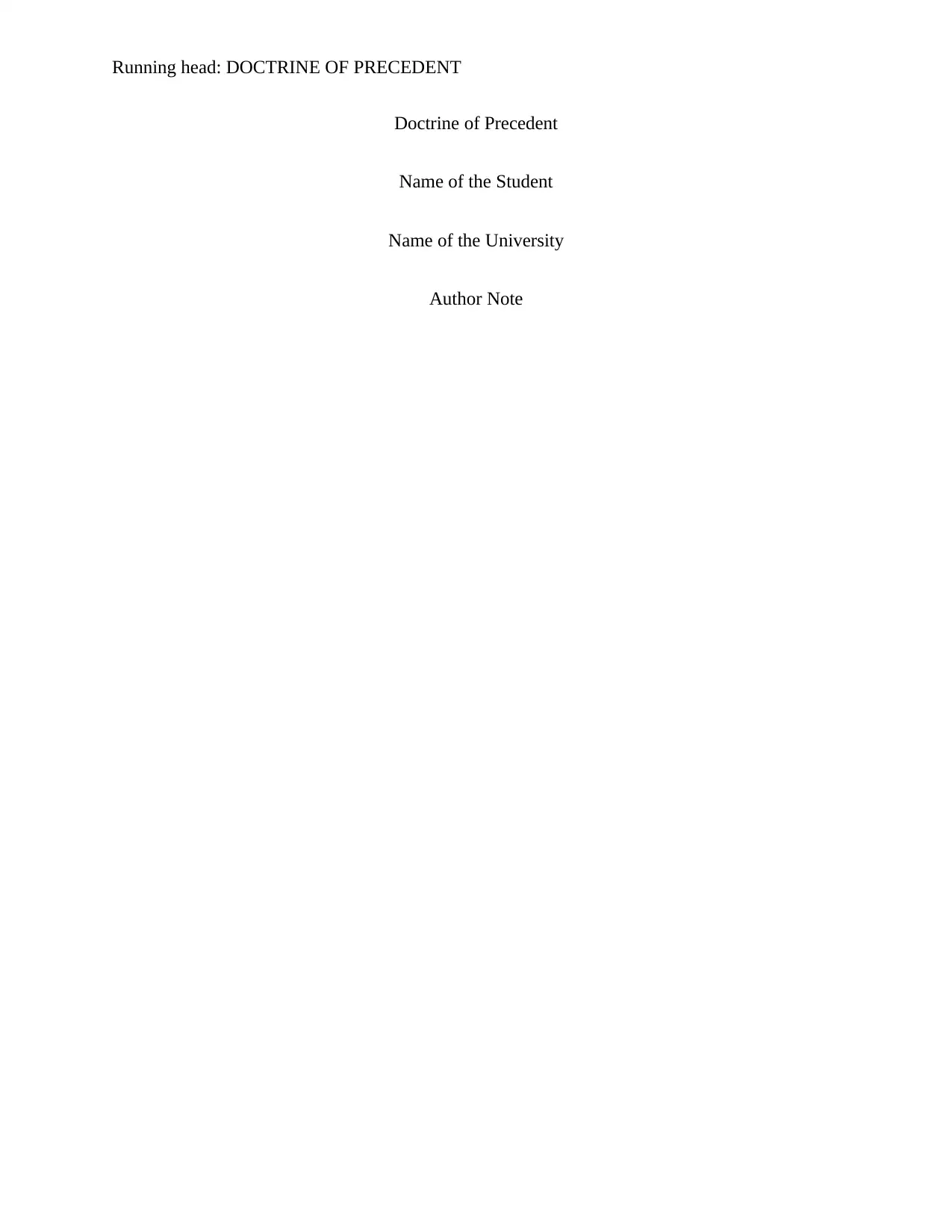
Running head: DOCTRINE OF PRECEDENT
Doctrine of Precedent
Name of the Student
Name of the University
Author Note
Doctrine of Precedent
Name of the Student
Name of the University
Author Note
Paraphrase This Document
Need a fresh take? Get an instant paraphrase of this document with our AI Paraphraser
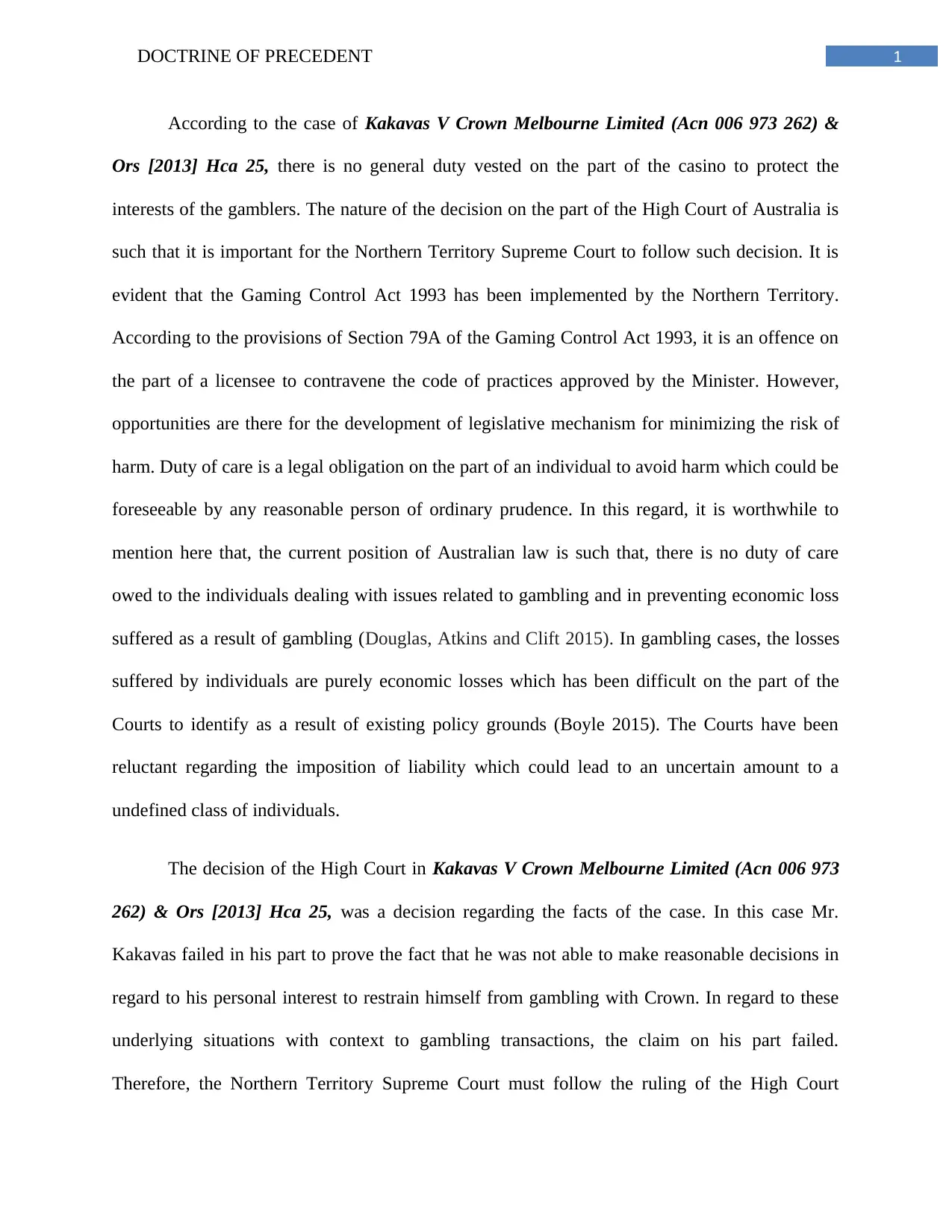
1DOCTRINE OF PRECEDENT
According to the case of Kakavas V Crown Melbourne Limited (Acn 006 973 262) &
Ors [2013] Hca 25, there is no general duty vested on the part of the casino to protect the
interests of the gamblers. The nature of the decision on the part of the High Court of Australia is
such that it is important for the Northern Territory Supreme Court to follow such decision. It is
evident that the Gaming Control Act 1993 has been implemented by the Northern Territory.
According to the provisions of Section 79A of the Gaming Control Act 1993, it is an offence on
the part of a licensee to contravene the code of practices approved by the Minister. However,
opportunities are there for the development of legislative mechanism for minimizing the risk of
harm. Duty of care is a legal obligation on the part of an individual to avoid harm which could be
foreseeable by any reasonable person of ordinary prudence. In this regard, it is worthwhile to
mention here that, the current position of Australian law is such that, there is no duty of care
owed to the individuals dealing with issues related to gambling and in preventing economic loss
suffered as a result of gambling (Douglas, Atkins and Clift 2015). In gambling cases, the losses
suffered by individuals are purely economic losses which has been difficult on the part of the
Courts to identify as a result of existing policy grounds (Boyle 2015). The Courts have been
reluctant regarding the imposition of liability which could lead to an uncertain amount to a
undefined class of individuals.
The decision of the High Court in Kakavas V Crown Melbourne Limited (Acn 006 973
262) & Ors [2013] Hca 25, was a decision regarding the facts of the case. In this case Mr.
Kakavas failed in his part to prove the fact that he was not able to make reasonable decisions in
regard to his personal interest to restrain himself from gambling with Crown. In regard to these
underlying situations with context to gambling transactions, the claim on his part failed.
Therefore, the Northern Territory Supreme Court must follow the ruling of the High Court
According to the case of Kakavas V Crown Melbourne Limited (Acn 006 973 262) &
Ors [2013] Hca 25, there is no general duty vested on the part of the casino to protect the
interests of the gamblers. The nature of the decision on the part of the High Court of Australia is
such that it is important for the Northern Territory Supreme Court to follow such decision. It is
evident that the Gaming Control Act 1993 has been implemented by the Northern Territory.
According to the provisions of Section 79A of the Gaming Control Act 1993, it is an offence on
the part of a licensee to contravene the code of practices approved by the Minister. However,
opportunities are there for the development of legislative mechanism for minimizing the risk of
harm. Duty of care is a legal obligation on the part of an individual to avoid harm which could be
foreseeable by any reasonable person of ordinary prudence. In this regard, it is worthwhile to
mention here that, the current position of Australian law is such that, there is no duty of care
owed to the individuals dealing with issues related to gambling and in preventing economic loss
suffered as a result of gambling (Douglas, Atkins and Clift 2015). In gambling cases, the losses
suffered by individuals are purely economic losses which has been difficult on the part of the
Courts to identify as a result of existing policy grounds (Boyle 2015). The Courts have been
reluctant regarding the imposition of liability which could lead to an uncertain amount to a
undefined class of individuals.
The decision of the High Court in Kakavas V Crown Melbourne Limited (Acn 006 973
262) & Ors [2013] Hca 25, was a decision regarding the facts of the case. In this case Mr.
Kakavas failed in his part to prove the fact that he was not able to make reasonable decisions in
regard to his personal interest to restrain himself from gambling with Crown. In regard to these
underlying situations with context to gambling transactions, the claim on his part failed.
Therefore, the Northern Territory Supreme Court must follow the ruling of the High Court
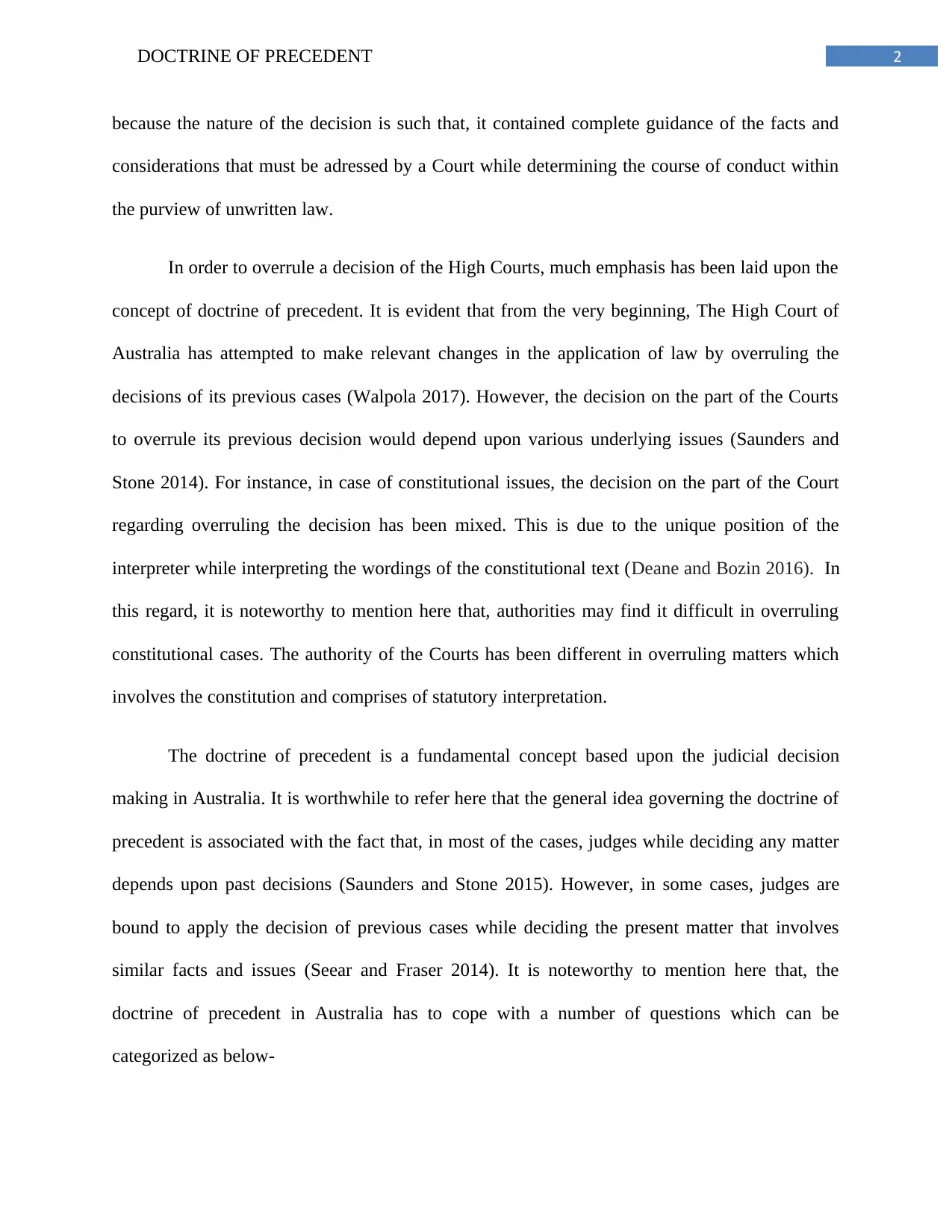
2DOCTRINE OF PRECEDENT
because the nature of the decision is such that, it contained complete guidance of the facts and
considerations that must be adressed by a Court while determining the course of conduct within
the purview of unwritten law.
In order to overrule a decision of the High Courts, much emphasis has been laid upon the
concept of doctrine of precedent. It is evident that from the very beginning, The High Court of
Australia has attempted to make relevant changes in the application of law by overruling the
decisions of its previous cases (Walpola 2017). However, the decision on the part of the Courts
to overrule its previous decision would depend upon various underlying issues (Saunders and
Stone 2014). For instance, in case of constitutional issues, the decision on the part of the Court
regarding overruling the decision has been mixed. This is due to the unique position of the
interpreter while interpreting the wordings of the constitutional text (Deane and Bozin 2016). In
this regard, it is noteworthy to mention here that, authorities may find it difficult in overruling
constitutional cases. The authority of the Courts has been different in overruling matters which
involves the constitution and comprises of statutory interpretation.
The doctrine of precedent is a fundamental concept based upon the judicial decision
making in Australia. It is worthwhile to refer here that the general idea governing the doctrine of
precedent is associated with the fact that, in most of the cases, judges while deciding any matter
depends upon past decisions (Saunders and Stone 2015). However, in some cases, judges are
bound to apply the decision of previous cases while deciding the present matter that involves
similar facts and issues (Seear and Fraser 2014). It is noteworthy to mention here that, the
doctrine of precedent in Australia has to cope with a number of questions which can be
categorized as below-
because the nature of the decision is such that, it contained complete guidance of the facts and
considerations that must be adressed by a Court while determining the course of conduct within
the purview of unwritten law.
In order to overrule a decision of the High Courts, much emphasis has been laid upon the
concept of doctrine of precedent. It is evident that from the very beginning, The High Court of
Australia has attempted to make relevant changes in the application of law by overruling the
decisions of its previous cases (Walpola 2017). However, the decision on the part of the Courts
to overrule its previous decision would depend upon various underlying issues (Saunders and
Stone 2014). For instance, in case of constitutional issues, the decision on the part of the Court
regarding overruling the decision has been mixed. This is due to the unique position of the
interpreter while interpreting the wordings of the constitutional text (Deane and Bozin 2016). In
this regard, it is noteworthy to mention here that, authorities may find it difficult in overruling
constitutional cases. The authority of the Courts has been different in overruling matters which
involves the constitution and comprises of statutory interpretation.
The doctrine of precedent is a fundamental concept based upon the judicial decision
making in Australia. It is worthwhile to refer here that the general idea governing the doctrine of
precedent is associated with the fact that, in most of the cases, judges while deciding any matter
depends upon past decisions (Saunders and Stone 2015). However, in some cases, judges are
bound to apply the decision of previous cases while deciding the present matter that involves
similar facts and issues (Seear and Fraser 2014). It is noteworthy to mention here that, the
doctrine of precedent in Australia has to cope with a number of questions which can be
categorized as below-
⊘ This is a preview!⊘
Do you want full access?
Subscribe today to unlock all pages.

Trusted by 1+ million students worldwide
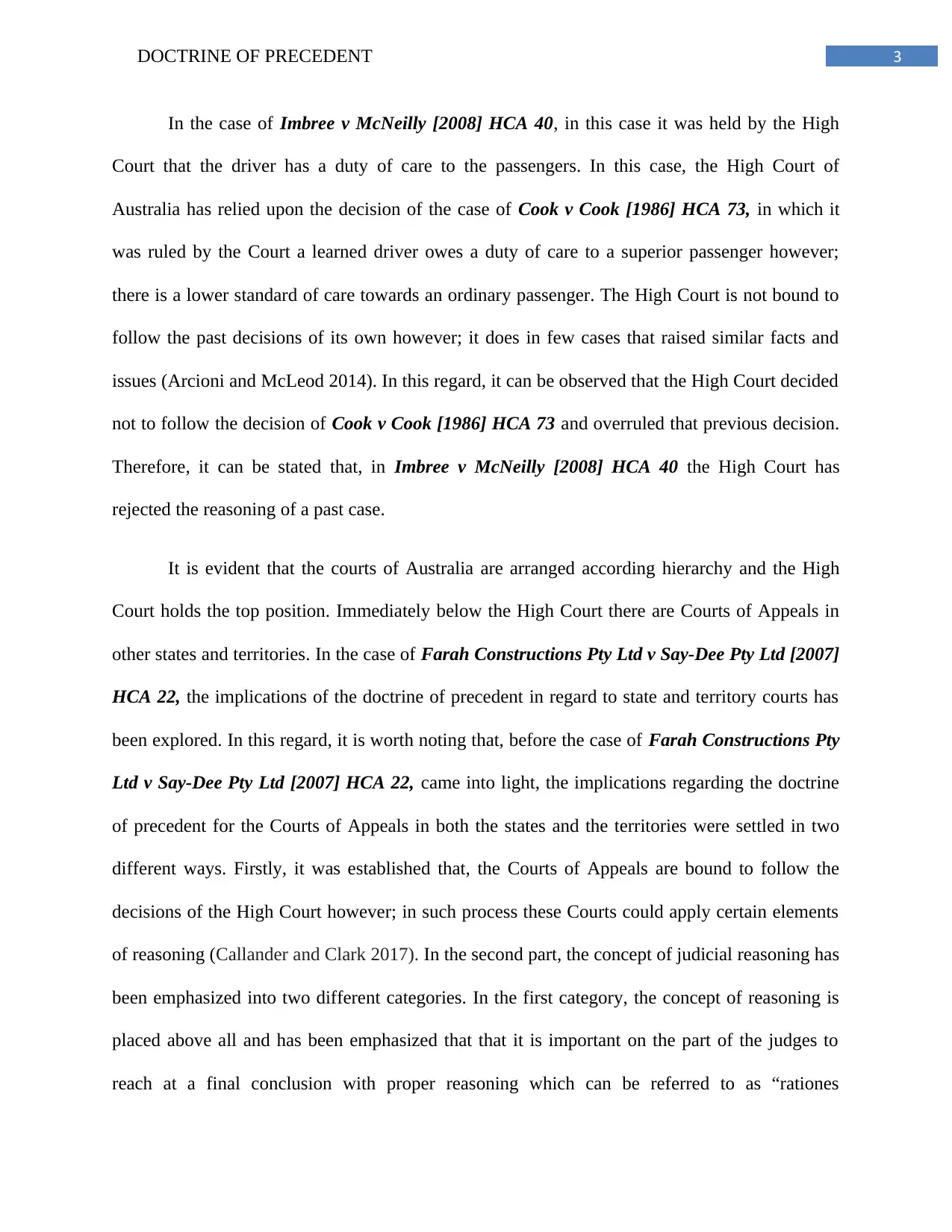
3DOCTRINE OF PRECEDENT
In the case of Imbree v McNeilly [2008] HCA 40, in this case it was held by the High
Court that the driver has a duty of care to the passengers. In this case, the High Court of
Australia has relied upon the decision of the case of Cook v Cook [1986] HCA 73, in which it
was ruled by the Court a learned driver owes a duty of care to a superior passenger however;
there is a lower standard of care towards an ordinary passenger. The High Court is not bound to
follow the past decisions of its own however; it does in few cases that raised similar facts and
issues (Arcioni and McLeod 2014). In this regard, it can be observed that the High Court decided
not to follow the decision of Cook v Cook [1986] HCA 73 and overruled that previous decision.
Therefore, it can be stated that, in Imbree v McNeilly [2008] HCA 40 the High Court has
rejected the reasoning of a past case.
It is evident that the courts of Australia are arranged according hierarchy and the High
Court holds the top position. Immediately below the High Court there are Courts of Appeals in
other states and territories. In the case of Farah Constructions Pty Ltd v Say-Dee Pty Ltd [2007]
HCA 22, the implications of the doctrine of precedent in regard to state and territory courts has
been explored. In this regard, it is worth noting that, before the case of Farah Constructions Pty
Ltd v Say-Dee Pty Ltd [2007] HCA 22, came into light, the implications regarding the doctrine
of precedent for the Courts of Appeals in both the states and the territories were settled in two
different ways. Firstly, it was established that, the Courts of Appeals are bound to follow the
decisions of the High Court however; in such process these Courts could apply certain elements
of reasoning (Callander and Clark 2017). In the second part, the concept of judicial reasoning has
been emphasized into two different categories. In the first category, the concept of reasoning is
placed above all and has been emphasized that that it is important on the part of the judges to
reach at a final conclusion with proper reasoning which can be referred to as “rationes
In the case of Imbree v McNeilly [2008] HCA 40, in this case it was held by the High
Court that the driver has a duty of care to the passengers. In this case, the High Court of
Australia has relied upon the decision of the case of Cook v Cook [1986] HCA 73, in which it
was ruled by the Court a learned driver owes a duty of care to a superior passenger however;
there is a lower standard of care towards an ordinary passenger. The High Court is not bound to
follow the past decisions of its own however; it does in few cases that raised similar facts and
issues (Arcioni and McLeod 2014). In this regard, it can be observed that the High Court decided
not to follow the decision of Cook v Cook [1986] HCA 73 and overruled that previous decision.
Therefore, it can be stated that, in Imbree v McNeilly [2008] HCA 40 the High Court has
rejected the reasoning of a past case.
It is evident that the courts of Australia are arranged according hierarchy and the High
Court holds the top position. Immediately below the High Court there are Courts of Appeals in
other states and territories. In the case of Farah Constructions Pty Ltd v Say-Dee Pty Ltd [2007]
HCA 22, the implications of the doctrine of precedent in regard to state and territory courts has
been explored. In this regard, it is worth noting that, before the case of Farah Constructions Pty
Ltd v Say-Dee Pty Ltd [2007] HCA 22, came into light, the implications regarding the doctrine
of precedent for the Courts of Appeals in both the states and the territories were settled in two
different ways. Firstly, it was established that, the Courts of Appeals are bound to follow the
decisions of the High Court however; in such process these Courts could apply certain elements
of reasoning (Callander and Clark 2017). In the second part, the concept of judicial reasoning has
been emphasized into two different categories. In the first category, the concept of reasoning is
placed above all and has been emphasized that that it is important on the part of the judges to
reach at a final conclusion with proper reasoning which can be referred to as “rationes
Paraphrase This Document
Need a fresh take? Get an instant paraphrase of this document with our AI Paraphraser
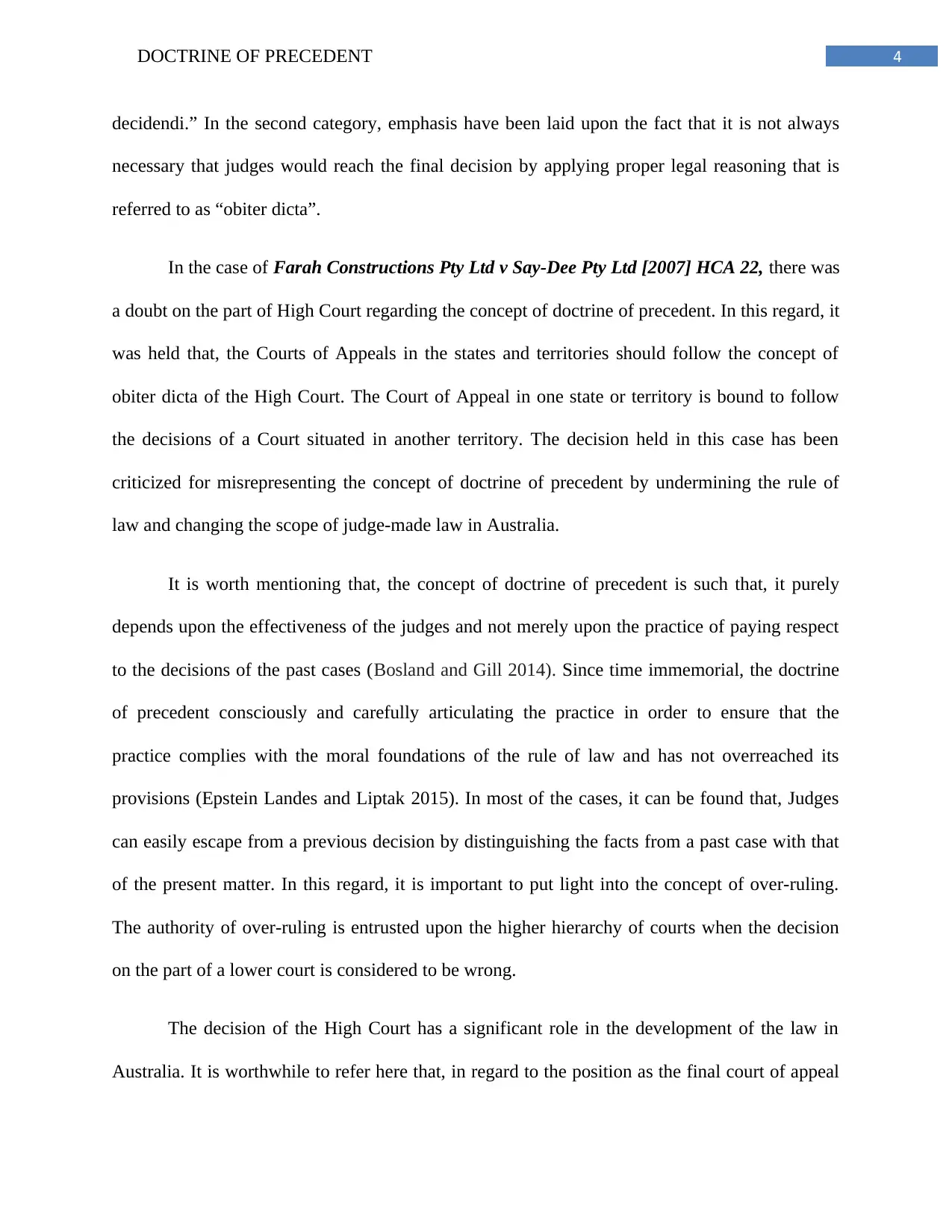
4DOCTRINE OF PRECEDENT
decidendi.” In the second category, emphasis have been laid upon the fact that it is not always
necessary that judges would reach the final decision by applying proper legal reasoning that is
referred to as “obiter dicta”.
In the case of Farah Constructions Pty Ltd v Say-Dee Pty Ltd [2007] HCA 22, there was
a doubt on the part of High Court regarding the concept of doctrine of precedent. In this regard, it
was held that, the Courts of Appeals in the states and territories should follow the concept of
obiter dicta of the High Court. The Court of Appeal in one state or territory is bound to follow
the decisions of a Court situated in another territory. The decision held in this case has been
criticized for misrepresenting the concept of doctrine of precedent by undermining the rule of
law and changing the scope of judge-made law in Australia.
It is worth mentioning that, the concept of doctrine of precedent is such that, it purely
depends upon the effectiveness of the judges and not merely upon the practice of paying respect
to the decisions of the past cases (Bosland and Gill 2014). Since time immemorial, the doctrine
of precedent consciously and carefully articulating the practice in order to ensure that the
practice complies with the moral foundations of the rule of law and has not overreached its
provisions (Epstein Landes and Liptak 2015). In most of the cases, it can be found that, Judges
can easily escape from a previous decision by distinguishing the facts from a past case with that
of the present matter. In this regard, it is important to put light into the concept of over-ruling.
The authority of over-ruling is entrusted upon the higher hierarchy of courts when the decision
on the part of a lower court is considered to be wrong.
The decision of the High Court has a significant role in the development of the law in
Australia. It is worthwhile to refer here that, in regard to the position as the final court of appeal
decidendi.” In the second category, emphasis have been laid upon the fact that it is not always
necessary that judges would reach the final decision by applying proper legal reasoning that is
referred to as “obiter dicta”.
In the case of Farah Constructions Pty Ltd v Say-Dee Pty Ltd [2007] HCA 22, there was
a doubt on the part of High Court regarding the concept of doctrine of precedent. In this regard, it
was held that, the Courts of Appeals in the states and territories should follow the concept of
obiter dicta of the High Court. The Court of Appeal in one state or territory is bound to follow
the decisions of a Court situated in another territory. The decision held in this case has been
criticized for misrepresenting the concept of doctrine of precedent by undermining the rule of
law and changing the scope of judge-made law in Australia.
It is worth mentioning that, the concept of doctrine of precedent is such that, it purely
depends upon the effectiveness of the judges and not merely upon the practice of paying respect
to the decisions of the past cases (Bosland and Gill 2014). Since time immemorial, the doctrine
of precedent consciously and carefully articulating the practice in order to ensure that the
practice complies with the moral foundations of the rule of law and has not overreached its
provisions (Epstein Landes and Liptak 2015). In most of the cases, it can be found that, Judges
can easily escape from a previous decision by distinguishing the facts from a past case with that
of the present matter. In this regard, it is important to put light into the concept of over-ruling.
The authority of over-ruling is entrusted upon the higher hierarchy of courts when the decision
on the part of a lower court is considered to be wrong.
The decision of the High Court has a significant role in the development of the law in
Australia. It is worthwhile to refer here that, in regard to the position as the final court of appeal
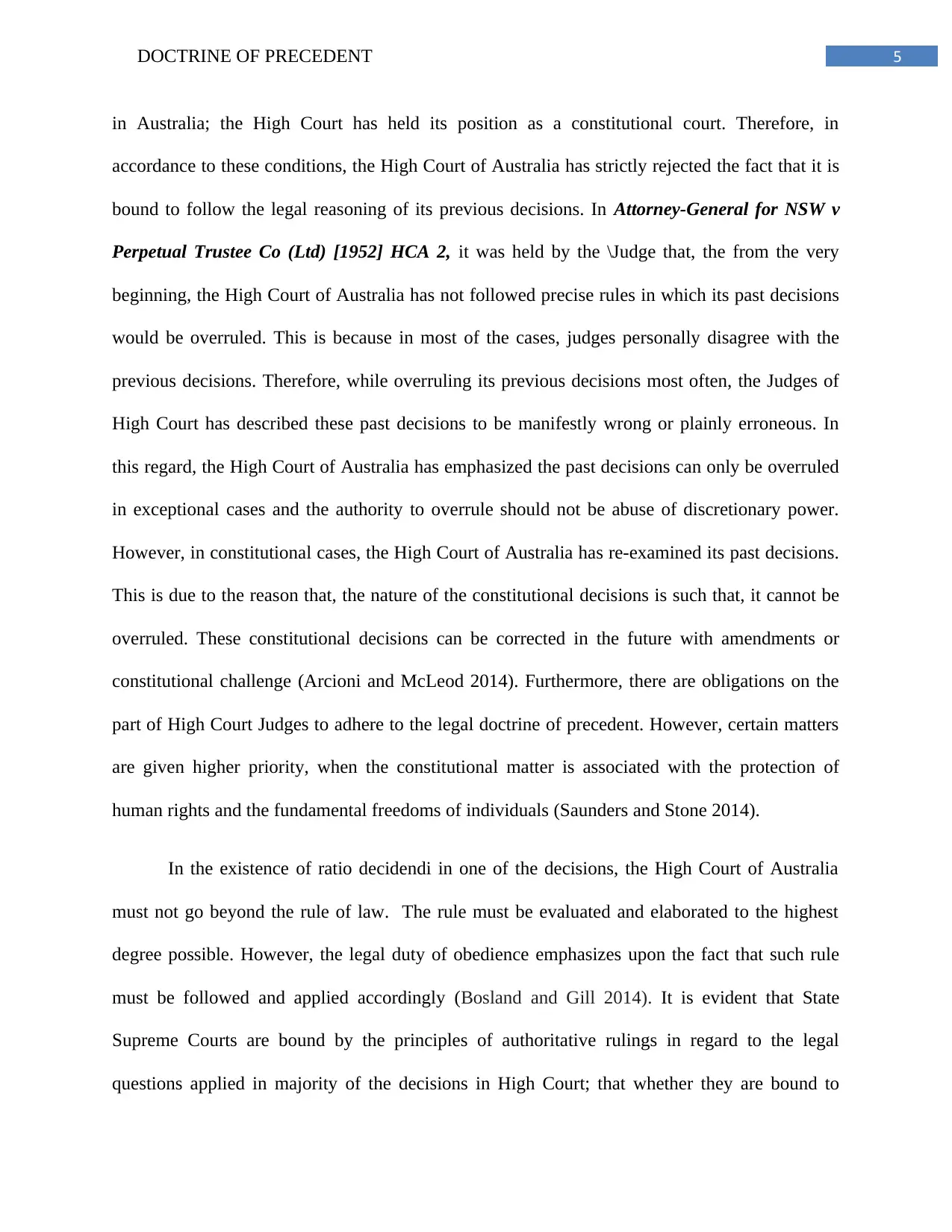
5DOCTRINE OF PRECEDENT
in Australia; the High Court has held its position as a constitutional court. Therefore, in
accordance to these conditions, the High Court of Australia has strictly rejected the fact that it is
bound to follow the legal reasoning of its previous decisions. In Attorney-General for NSW v
Perpetual Trustee Co (Ltd) [1952] HCA 2, it was held by the \Judge that, the from the very
beginning, the High Court of Australia has not followed precise rules in which its past decisions
would be overruled. This is because in most of the cases, judges personally disagree with the
previous decisions. Therefore, while overruling its previous decisions most often, the Judges of
High Court has described these past decisions to be manifestly wrong or plainly erroneous. In
this regard, the High Court of Australia has emphasized the past decisions can only be overruled
in exceptional cases and the authority to overrule should not be abuse of discretionary power.
However, in constitutional cases, the High Court of Australia has re-examined its past decisions.
This is due to the reason that, the nature of the constitutional decisions is such that, it cannot be
overruled. These constitutional decisions can be corrected in the future with amendments or
constitutional challenge (Arcioni and McLeod 2014). Furthermore, there are obligations on the
part of High Court Judges to adhere to the legal doctrine of precedent. However, certain matters
are given higher priority, when the constitutional matter is associated with the protection of
human rights and the fundamental freedoms of individuals (Saunders and Stone 2014).
In the existence of ratio decidendi in one of the decisions, the High Court of Australia
must not go beyond the rule of law. The rule must be evaluated and elaborated to the highest
degree possible. However, the legal duty of obedience emphasizes upon the fact that such rule
must be followed and applied accordingly (Bosland and Gill 2014). It is evident that State
Supreme Courts are bound by the principles of authoritative rulings in regard to the legal
questions applied in majority of the decisions in High Court; that whether they are bound to
in Australia; the High Court has held its position as a constitutional court. Therefore, in
accordance to these conditions, the High Court of Australia has strictly rejected the fact that it is
bound to follow the legal reasoning of its previous decisions. In Attorney-General for NSW v
Perpetual Trustee Co (Ltd) [1952] HCA 2, it was held by the \Judge that, the from the very
beginning, the High Court of Australia has not followed precise rules in which its past decisions
would be overruled. This is because in most of the cases, judges personally disagree with the
previous decisions. Therefore, while overruling its previous decisions most often, the Judges of
High Court has described these past decisions to be manifestly wrong or plainly erroneous. In
this regard, the High Court of Australia has emphasized the past decisions can only be overruled
in exceptional cases and the authority to overrule should not be abuse of discretionary power.
However, in constitutional cases, the High Court of Australia has re-examined its past decisions.
This is due to the reason that, the nature of the constitutional decisions is such that, it cannot be
overruled. These constitutional decisions can be corrected in the future with amendments or
constitutional challenge (Arcioni and McLeod 2014). Furthermore, there are obligations on the
part of High Court Judges to adhere to the legal doctrine of precedent. However, certain matters
are given higher priority, when the constitutional matter is associated with the protection of
human rights and the fundamental freedoms of individuals (Saunders and Stone 2014).
In the existence of ratio decidendi in one of the decisions, the High Court of Australia
must not go beyond the rule of law. The rule must be evaluated and elaborated to the highest
degree possible. However, the legal duty of obedience emphasizes upon the fact that such rule
must be followed and applied accordingly (Bosland and Gill 2014). It is evident that State
Supreme Courts are bound by the principles of authoritative rulings in regard to the legal
questions applied in majority of the decisions in High Court; that whether they are bound to
⊘ This is a preview!⊘
Do you want full access?
Subscribe today to unlock all pages.

Trusted by 1+ million students worldwide
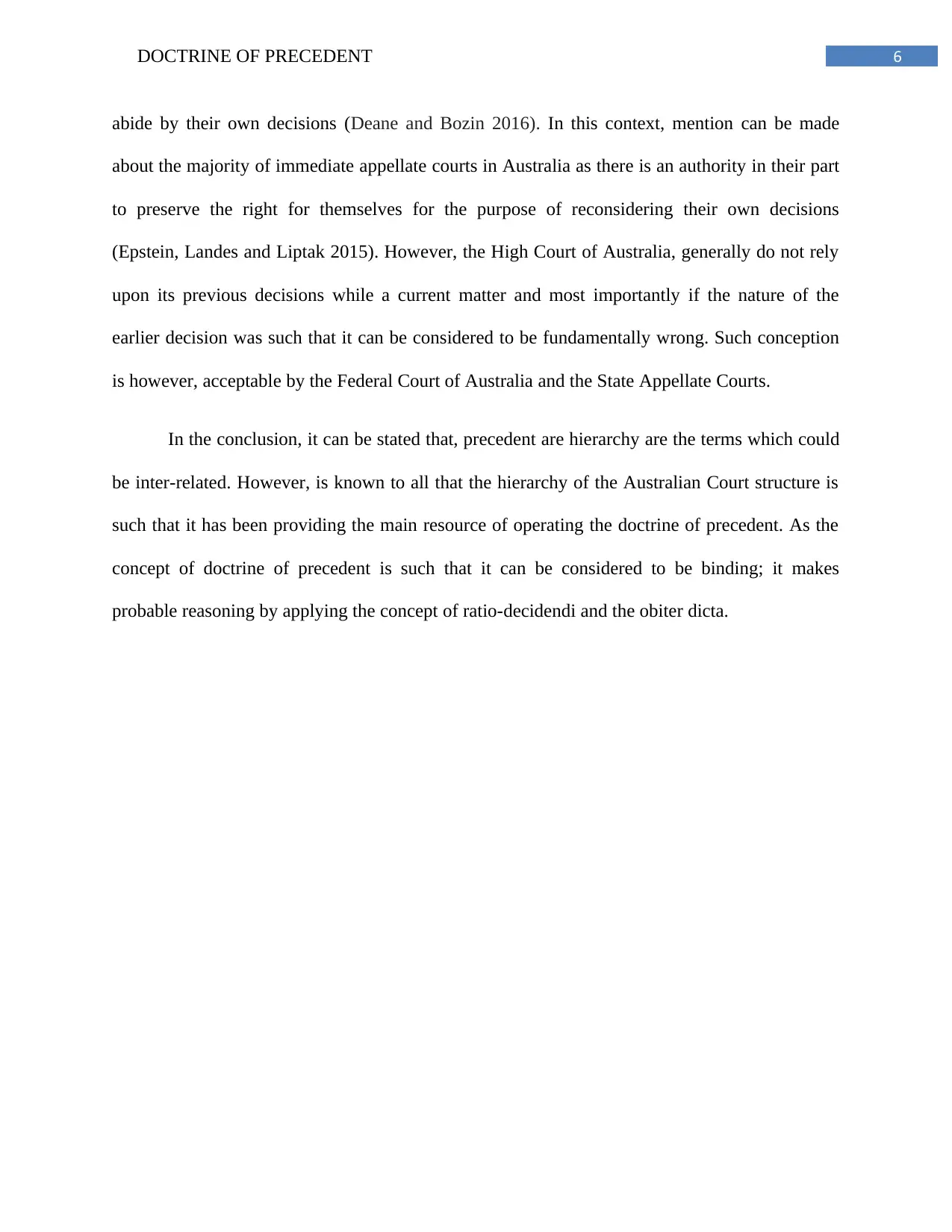
6DOCTRINE OF PRECEDENT
abide by their own decisions (Deane and Bozin 2016). In this context, mention can be made
about the majority of immediate appellate courts in Australia as there is an authority in their part
to preserve the right for themselves for the purpose of reconsidering their own decisions
(Epstein, Landes and Liptak 2015). However, the High Court of Australia, generally do not rely
upon its previous decisions while a current matter and most importantly if the nature of the
earlier decision was such that it can be considered to be fundamentally wrong. Such conception
is however, acceptable by the Federal Court of Australia and the State Appellate Courts.
In the conclusion, it can be stated that, precedent are hierarchy are the terms which could
be inter-related. However, is known to all that the hierarchy of the Australian Court structure is
such that it has been providing the main resource of operating the doctrine of precedent. As the
concept of doctrine of precedent is such that it can be considered to be binding; it makes
probable reasoning by applying the concept of ratio-decidendi and the obiter dicta.
abide by their own decisions (Deane and Bozin 2016). In this context, mention can be made
about the majority of immediate appellate courts in Australia as there is an authority in their part
to preserve the right for themselves for the purpose of reconsidering their own decisions
(Epstein, Landes and Liptak 2015). However, the High Court of Australia, generally do not rely
upon its previous decisions while a current matter and most importantly if the nature of the
earlier decision was such that it can be considered to be fundamentally wrong. Such conception
is however, acceptable by the Federal Court of Australia and the State Appellate Courts.
In the conclusion, it can be stated that, precedent are hierarchy are the terms which could
be inter-related. However, is known to all that the hierarchy of the Australian Court structure is
such that it has been providing the main resource of operating the doctrine of precedent. As the
concept of doctrine of precedent is such that it can be considered to be binding; it makes
probable reasoning by applying the concept of ratio-decidendi and the obiter dicta.
Paraphrase This Document
Need a fresh take? Get an instant paraphrase of this document with our AI Paraphraser
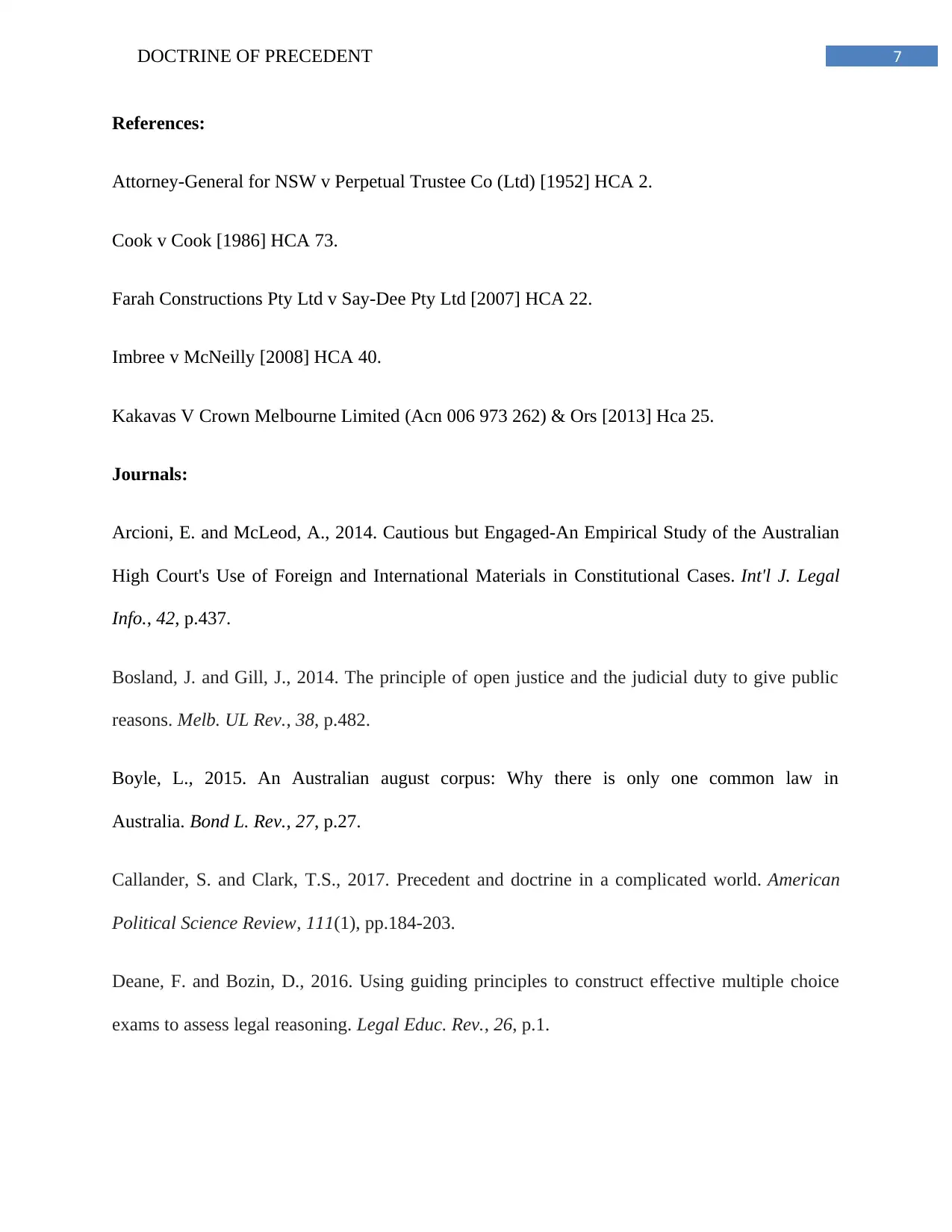
7DOCTRINE OF PRECEDENT
References:
Attorney-General for NSW v Perpetual Trustee Co (Ltd) [1952] HCA 2.
Cook v Cook [1986] HCA 73.
Farah Constructions Pty Ltd v Say-Dee Pty Ltd [2007] HCA 22.
Imbree v McNeilly [2008] HCA 40.
Kakavas V Crown Melbourne Limited (Acn 006 973 262) & Ors [2013] Hca 25.
Journals:
Arcioni, E. and McLeod, A., 2014. Cautious but Engaged-An Empirical Study of the Australian
High Court's Use of Foreign and International Materials in Constitutional Cases. Int'l J. Legal
Info., 42, p.437.
Bosland, J. and Gill, J., 2014. The principle of open justice and the judicial duty to give public
reasons. Melb. UL Rev., 38, p.482.
Boyle, L., 2015. An Australian august corpus: Why there is only one common law in
Australia. Bond L. Rev., 27, p.27.
Callander, S. and Clark, T.S., 2017. Precedent and doctrine in a complicated world. American
Political Science Review, 111(1), pp.184-203.
Deane, F. and Bozin, D., 2016. Using guiding principles to construct effective multiple choice
exams to assess legal reasoning. Legal Educ. Rev., 26, p.1.
References:
Attorney-General for NSW v Perpetual Trustee Co (Ltd) [1952] HCA 2.
Cook v Cook [1986] HCA 73.
Farah Constructions Pty Ltd v Say-Dee Pty Ltd [2007] HCA 22.
Imbree v McNeilly [2008] HCA 40.
Kakavas V Crown Melbourne Limited (Acn 006 973 262) & Ors [2013] Hca 25.
Journals:
Arcioni, E. and McLeod, A., 2014. Cautious but Engaged-An Empirical Study of the Australian
High Court's Use of Foreign and International Materials in Constitutional Cases. Int'l J. Legal
Info., 42, p.437.
Bosland, J. and Gill, J., 2014. The principle of open justice and the judicial duty to give public
reasons. Melb. UL Rev., 38, p.482.
Boyle, L., 2015. An Australian august corpus: Why there is only one common law in
Australia. Bond L. Rev., 27, p.27.
Callander, S. and Clark, T.S., 2017. Precedent and doctrine in a complicated world. American
Political Science Review, 111(1), pp.184-203.
Deane, F. and Bozin, D., 2016. Using guiding principles to construct effective multiple choice
exams to assess legal reasoning. Legal Educ. Rev., 26, p.1.
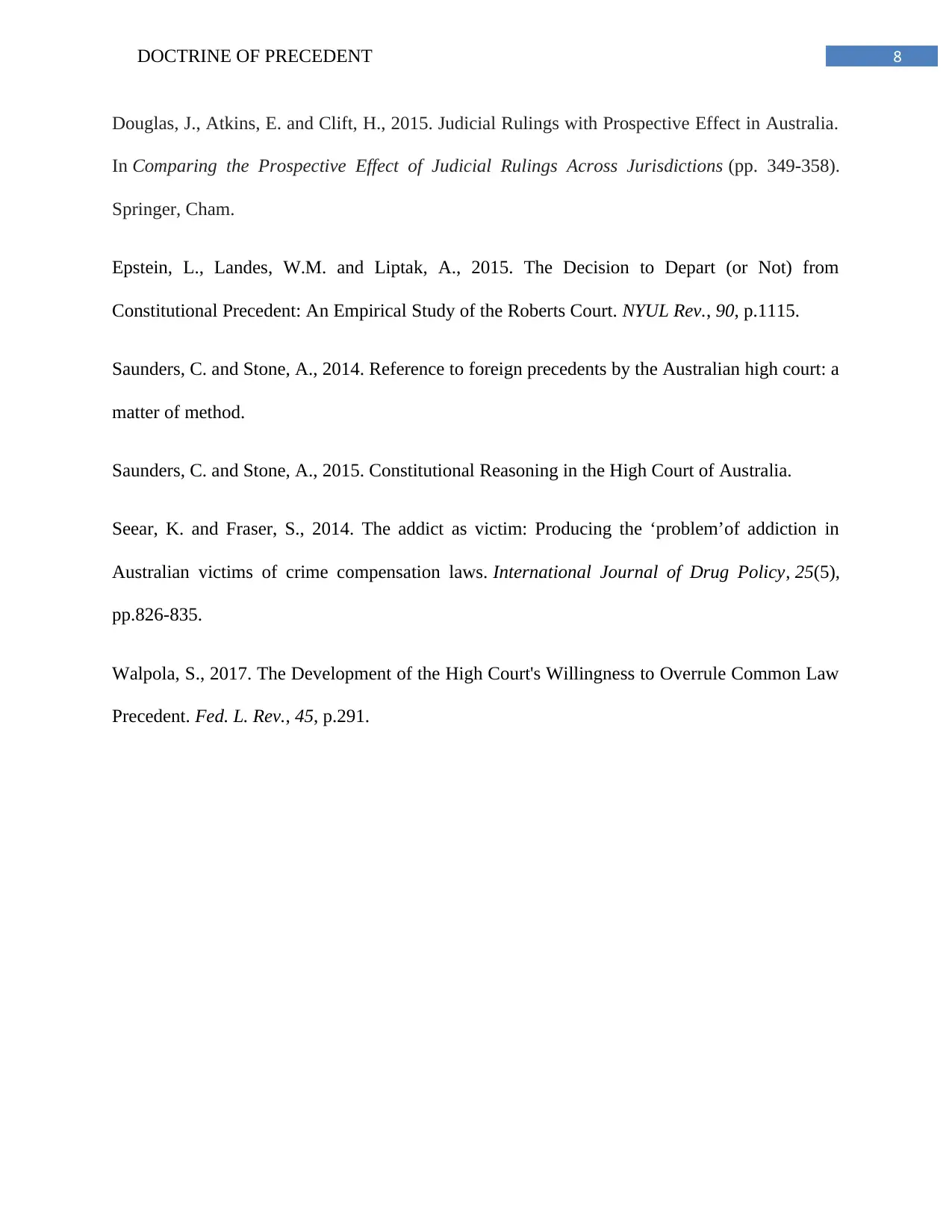
8DOCTRINE OF PRECEDENT
Douglas, J., Atkins, E. and Clift, H., 2015. Judicial Rulings with Prospective Effect in Australia.
In Comparing the Prospective Effect of Judicial Rulings Across Jurisdictions (pp. 349-358).
Springer, Cham.
Epstein, L., Landes, W.M. and Liptak, A., 2015. The Decision to Depart (or Not) from
Constitutional Precedent: An Empirical Study of the Roberts Court. NYUL Rev., 90, p.1115.
Saunders, C. and Stone, A., 2014. Reference to foreign precedents by the Australian high court: a
matter of method.
Saunders, C. and Stone, A., 2015. Constitutional Reasoning in the High Court of Australia.
Seear, K. and Fraser, S., 2014. The addict as victim: Producing the ‘problem’of addiction in
Australian victims of crime compensation laws. International Journal of Drug Policy, 25(5),
pp.826-835.
Walpola, S., 2017. The Development of the High Court's Willingness to Overrule Common Law
Precedent. Fed. L. Rev., 45, p.291.
Douglas, J., Atkins, E. and Clift, H., 2015. Judicial Rulings with Prospective Effect in Australia.
In Comparing the Prospective Effect of Judicial Rulings Across Jurisdictions (pp. 349-358).
Springer, Cham.
Epstein, L., Landes, W.M. and Liptak, A., 2015. The Decision to Depart (or Not) from
Constitutional Precedent: An Empirical Study of the Roberts Court. NYUL Rev., 90, p.1115.
Saunders, C. and Stone, A., 2014. Reference to foreign precedents by the Australian high court: a
matter of method.
Saunders, C. and Stone, A., 2015. Constitutional Reasoning in the High Court of Australia.
Seear, K. and Fraser, S., 2014. The addict as victim: Producing the ‘problem’of addiction in
Australian victims of crime compensation laws. International Journal of Drug Policy, 25(5),
pp.826-835.
Walpola, S., 2017. The Development of the High Court's Willingness to Overrule Common Law
Precedent. Fed. L. Rev., 45, p.291.
⊘ This is a preview!⊘
Do you want full access?
Subscribe today to unlock all pages.

Trusted by 1+ million students worldwide
1 out of 9
Your All-in-One AI-Powered Toolkit for Academic Success.
+13062052269
info@desklib.com
Available 24*7 on WhatsApp / Email
![[object Object]](/_next/static/media/star-bottom.7253800d.svg)
Unlock your academic potential
Copyright © 2020–2025 A2Z Services. All Rights Reserved. Developed and managed by ZUCOL.
